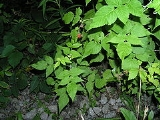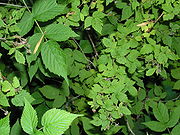
Rubus strigosus
Encyclopedia
Rubus strigosus, the American Red Raspberry or American Raspberry, is a species of Rubus
native to much of North America
. It has often been treated as a variety
or subspecies
of the closely related Eurasian Rubus idaeus
(Raspberry or European Raspberry), but currently is more commonly treated as a distinct species.
Rubus idaeus, and others recognizing two (or more) species within this group. The two species share many similarities, and probably recently diverged from a common ancestor, leading to differences in taxonomic interpretation, particularly regarding the more intermediate eastern Asian plants. A common current treatment, followed here, is to classify the North American red raspberries as Rubus strigosus, and include only the Eurasian plants in Rubus idaeus. When the species are combined, as done in some recent publications, the Eurasian plants are Rubus idaeus ssp. idaeus (or Rubus idaeus var. idaeus), and the American plants R. idaeus ssp. strigosus (or R. idaeus var. strigosus). Different interpretations are also sometimes made regarding placement of various eastern Asian populations of this group, by some considered to represent additional varieties or subspecies, if not different species altogether. The most distinctive physical difference among these plants is usual presence of gland
-tipped hairs on first-year canes, petioles, pedicels, and calyces of R. strigosus, lacking in R. idaeus.

which bears biennial
stems ("canes") from the perennial root system. In its first year, a new stem grows vigorously to its full height of 0.5–2 m, unbranched, and bearing large pinnate leaves
with three or five (rarely seven) leaflets; normally it does not produce any flowers. In its second year, the stem does not grow taller, but produces several side shoots, which bear smaller leaves with three leaflets.
The flower
s are produced in late spring on short raceme
s on the tips of these side shoots, each flower with five white petal
s 4–7 mm long. The fruit
is 1–1.2 cm diameter, red, edible, sweet but tart-flavored, produced in summer or early autumn; in botanical
terminology, it is not a berry
at all, but an aggregate fruit of numerous drupe
lets around a central core.
Many of the commercial raspberry cultivar
s grown for their fruit derive from hybrids between Rubus strigosus and R. idaeus; see Raspberry
for more details.
Rubus
Rubus is a large genus of flowering plants in the rose family, Rosaceae, subfamily Rosoideae. Raspberries, blackberries, and dewberries are common, widely distributed members of the genus. Most of these plants have woody stems with prickles like roses; spines, bristles, and gland-tipped hairs are...
native to much of North America
North America
North America is a continent wholly within the Northern Hemisphere and almost wholly within the Western Hemisphere. It is also considered a northern subcontinent of the Americas...
. It has often been treated as a variety
Variety (biology)
In botanical nomenclature, variety is a taxonomic rank below that of species: as such, it gets a three-part infraspecific name....
or subspecies
Subspecies
Subspecies in biological classification, is either a taxonomic rank subordinate to species, ora taxonomic unit in that rank . A subspecies cannot be recognized in isolation: a species will either be recognized as having no subspecies at all or two or more, never just one...
of the closely related Eurasian Rubus idaeus
Rubus idaeus
Rubus idaeus is a red-fruited species of Rubus native to Europe and northern Asia and commonly cultivated in other temperate regions. A closely related plant in North America, sometimes regarded as the variety Rubus idaeus var...
(Raspberry or European Raspberry), but currently is more commonly treated as a distinct species.
Classification
Botanists have long debated the taxonomic treatment of the Eurasian and American red raspberries, with some viewing all of these plants as members of a single, circumboreal speciesSpecies
In biology, a species is one of the basic units of biological classification and a taxonomic rank. A species is often defined as a group of organisms capable of interbreeding and producing fertile offspring. While in many cases this definition is adequate, more precise or differing measures are...
Rubus idaeus, and others recognizing two (or more) species within this group. The two species share many similarities, and probably recently diverged from a common ancestor, leading to differences in taxonomic interpretation, particularly regarding the more intermediate eastern Asian plants. A common current treatment, followed here, is to classify the North American red raspberries as Rubus strigosus, and include only the Eurasian plants in Rubus idaeus. When the species are combined, as done in some recent publications, the Eurasian plants are Rubus idaeus ssp. idaeus (or Rubus idaeus var. idaeus), and the American plants R. idaeus ssp. strigosus (or R. idaeus var. strigosus). Different interpretations are also sometimes made regarding placement of various eastern Asian populations of this group, by some considered to represent additional varieties or subspecies, if not different species altogether. The most distinctive physical difference among these plants is usual presence of gland
Gland
A gland is an organ in an animal's body that synthesizes a substance for release of substances such as hormones or breast milk, often into the bloodstream or into cavities inside the body or its outer surface .- Types :...
-tipped hairs on first-year canes, petioles, pedicels, and calyces of R. strigosus, lacking in R. idaeus.
Distribution
Rubus strigosus, as treated here, is widely distributed in North America, particularly the more boreal regions. Some authors also treat various raspberries in eastern Asia, east from the Aerhtal Shan (Altai) Mountain Range in Mongolia to Dongbei (Manchuria) and Japan in this taxon (where it is suggested to have originated along with a great deal of the North American flora), but others include all Asian raspberries in R. idaeus. with the Eurasian plants being Rubus idaeus ssp. (or var.) idaeus.
Description
Rubus strigosus is a perennial plantPerennial plant
A perennial plant or simply perennial is a plant that lives for more than two years. The term is often used to differentiate a plant from shorter lived annuals and biennials. The term is sometimes misused by commercial gardeners or horticulturalists to describe only herbaceous perennials...
which bears biennial
Biennial plant
A biennial plant is a flowering plant that takes two years to complete its biological lifecycle. In the first year the plant grows leaves, stems, and roots , then it enters a period of dormancy over the colder months. Usually the stem remains very short and the leaves are low to the ground, forming...
stems ("canes") from the perennial root system. In its first year, a new stem grows vigorously to its full height of 0.5–2 m, unbranched, and bearing large pinnate leaves
Leaf
A leaf is an organ of a vascular plant, as defined in botanical terms, and in particular in plant morphology. Foliage is a mass noun that refers to leaves as a feature of plants....
with three or five (rarely seven) leaflets; normally it does not produce any flowers. In its second year, the stem does not grow taller, but produces several side shoots, which bear smaller leaves with three leaflets.
The flower
Flower
A flower, sometimes known as a bloom or blossom, is the reproductive structure found in flowering plants . The biological function of a flower is to effect reproduction, usually by providing a mechanism for the union of sperm with eggs...
s are produced in late spring on short raceme
Raceme
A raceme is a type of inflorescence that is unbranched and indeterminate and bears pedicellate flowers — flowers having short floral stalks called pedicels — along the axis. In botany, axis means a shoot, in this case one bearing the flowers. In a raceme, the oldest flowers are borne...
s on the tips of these side shoots, each flower with five white petal
Petal
Petals are modified leaves that surround the reproductive parts of flowers. They often are brightly colored or unusually shaped to attract pollinators. Together, all of the petals of a flower are called a corolla. Petals are usually accompanied by another set of special leaves called sepals lying...
s 4–7 mm long. The fruit
Fruit
In broad terms, a fruit is a structure of a plant that contains its seeds.The term has different meanings dependent on context. In non-technical usage, such as food preparation, fruit normally means the fleshy seed-associated structures of certain plants that are sweet and edible in the raw state,...
is 1–1.2 cm diameter, red, edible, sweet but tart-flavored, produced in summer or early autumn; in botanical
Botany
Botany, plant science, or plant biology is a branch of biology that involves the scientific study of plant life. Traditionally, botany also included the study of fungi, algae and viruses...
terminology, it is not a berry
Berry
The botanical definition of a berry is a fleshy fruit produced from a single ovary. Grapes are an example. The berry is the most common type of fleshy fruit in which the entire ovary wall ripens into an edible pericarp. They may have one or more carpels with a thin covering and fleshy interiors....
at all, but an aggregate fruit of numerous drupe
Drupe
In botany, a drupe is a fruit in which an outer fleshy part surrounds a shell of hardened endocarp with a seed inside. These fruits develop from a single carpel, and mostly from flowers with superior ovaries...
lets around a central core.
Many of the commercial raspberry cultivar
Cultivar
A cultivar'Cultivar has two meanings as explained under Formal definition. When used in reference to a taxon, the word does not apply to an individual plant but to all those plants sharing the unique characteristics that define the cultivar. is a plant or group of plants selected for desirable...
s grown for their fruit derive from hybrids between Rubus strigosus and R. idaeus; see Raspberry
Raspberry
The raspberry or hindberry is the edible fruit of a multitude of plant species in the genus Rubus, most of which are in the subgenus Idaeobatus; the name also applies to these plants themselves...
for more details.

